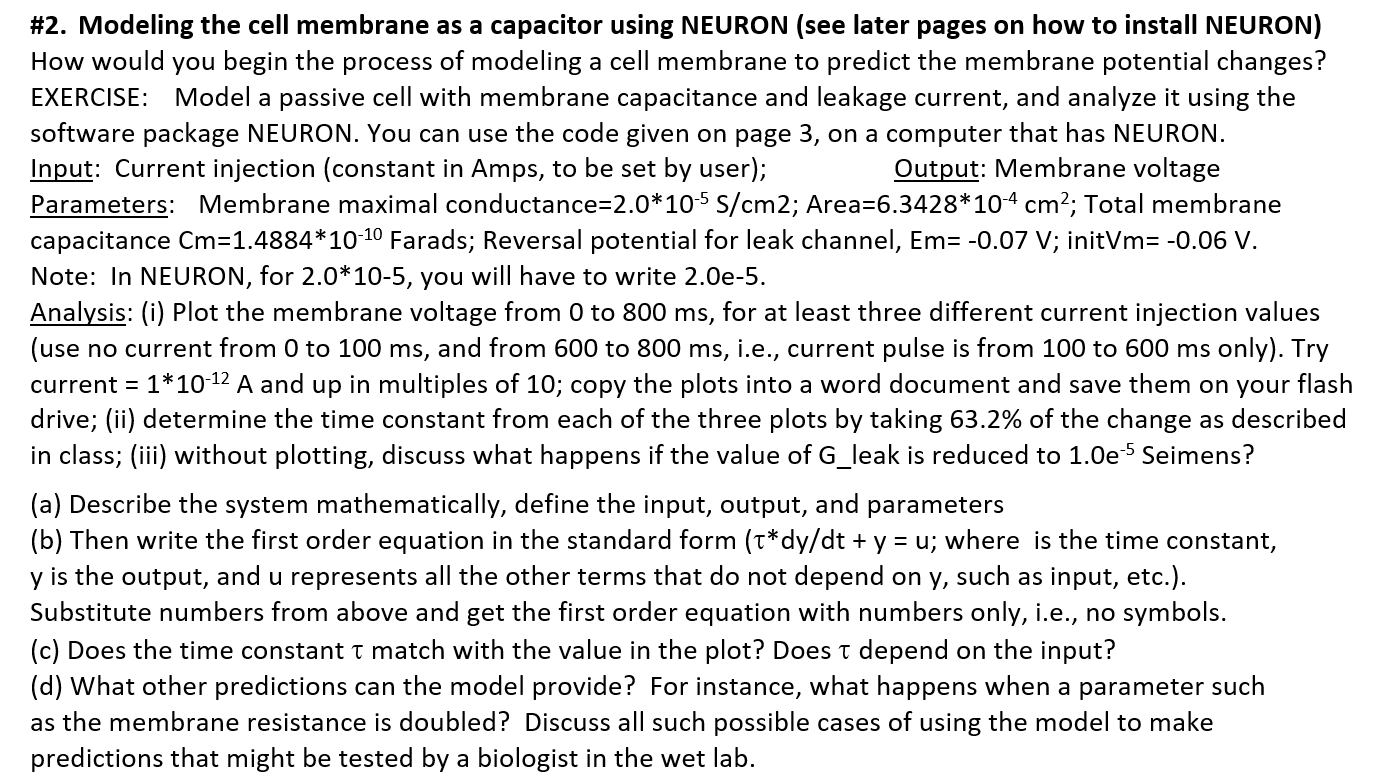Question
NEURON Program for question #2 // passive.hoc MODELING A SINGLE CELL WITH PASSIVE MEMBRANE // AND CURRENT INJECTION load_file(nrngui.hoc) create soma access soma soma nseg

NEURON Program for question #2
// passive.hoc MODELING A SINGLE CELL WITH PASSIVE MEMBRANE
// AND CURRENT INJECTION
load_file("nrngui.hoc")
create soma
access soma
soma nseg = 1
soma diam = 200 //um
soma L = 100 //um
//Note that NEURON assumes cm, and gl_hh as being in units of /cm2
soma cm = 1.4884e-4/6.2832e-4 // uF/cm2
// inserts the passive (leak) channel and assign value.
soma insert hh
gnabar_hh = 0
gkbar_hh = 0
gl_hh = 2.0e-5 //S/cm2
el_hh = -70 //mV
//set initial value of voltage to -60 mV; default is -65 mV
v_init = -60
objectvar stim
//create current clamp in the middle of the soma
soma stim = new IClamp(0.5)
stim.del = 100 // in ms
stim.dur = 500 // in ms
// NEURON assumes injection current to be over the entire area
stim.amp = 1 // in nA
tstop = 800 // in ms
// use procedure on the previous pages to plot voltage v/s time
#2. Modeling the cell membrane as a capacitor using NEURON (see later pages on how to install NEURON) How would you begin the process of modeling a cell membrane to predict the membrane potential changes? EXERCISE: Model a passive cell with membrane capacitance and leakage current, and analyze it using the software package NEURON. You can use the code given on page 3, on a computer that has NEURON. Input: Current injection (constant in Amps, to be set by user); Output: Membrane voltage Parameters: Membrane maximal conductance=2.0*10-5 S/cm2; Area=6.3428*10-4 cm2; Total membrane capacitance Cm=1.4884*10-10 Farads; Reversal potential for leak channel, Em=-0.07 V; initVm= -0.06 V. Note: In NEURON, for 2.0*10-5, you will have to write 2.0e-5. Analysis: (i) Plot the membrane voltage from 0 to 800 ms, for at least three different current injection values (use no current from 0 to 100 ms, and from 600 to 800 ms, i.e., current pulse is from 100 to 600 ms only). Try current = 1*10-12 A and up in multiples of 10; copy the plots into a word document and save them on your flash drive; (ii) determine the time constant from each of the three plots by taking 63.2% of the change as described in class; (iii) without plotting, discuss what happens if the value of G_leak is reduced to 1.0e-5 Seimens? (a) Describe the system mathematically, define the input, output, and parameters (b) Then write the first order equation in the standard form (T*dy/dt + y = u; where is the time constant, y is the output, and u represents all the other terms that do not depend on y, such as input, etc.). Substitute numbers from above and get the first order equation with numbers only, i.e., no symbols. (c) Does the time constant t match with the value in the plot? Does t depend on the input? (d) What other predictions can the model provide? For instance, what happens when a parameter such as the membrane resistance is doubled? Discuss all such possible cases of using the model to make predictions that might be tested by a biologist in the wet lab. #2. Modeling the cell membrane as a capacitor using NEURON (see later pages on how to install NEURON) How would you begin the process of modeling a cell membrane to predict the membrane potential changes? EXERCISE: Model a passive cell with membrane capacitance and leakage current, and analyze it using the software package NEURON. You can use the code given on page 3, on a computer that has NEURON. Input: Current injection (constant in Amps, to be set by user); Output: Membrane voltage Parameters: Membrane maximal conductance=2.0*10-5 S/cm2; Area=6.3428*10-4 cm2; Total membrane capacitance Cm=1.4884*10-10 Farads; Reversal potential for leak channel, Em=-0.07 V; initVm= -0.06 V. Note: In NEURON, for 2.0*10-5, you will have to write 2.0e-5. Analysis: (i) Plot the membrane voltage from 0 to 800 ms, for at least three different current injection values (use no current from 0 to 100 ms, and from 600 to 800 ms, i.e., current pulse is from 100 to 600 ms only). Try current = 1*10-12 A and up in multiples of 10; copy the plots into a word document and save them on your flash drive; (ii) determine the time constant from each of the three plots by taking 63.2% of the change as described in class; (iii) without plotting, discuss what happens if the value of G_leak is reduced to 1.0e-5 Seimens? (a) Describe the system mathematically, define the input, output, and parameters (b) Then write the first order equation in the standard form (T*dy/dt + y = u; where is the time constant, y is the output, and u represents all the other terms that do not depend on y, such as input, etc.). Substitute numbers from above and get the first order equation with numbers only, i.e., no symbols. (c) Does the time constant t match with the value in the plot? Does t depend on the input? (d) What other predictions can the model provide? For instance, what happens when a parameter such as the membrane resistance is doubled? Discuss all such possible cases of using the model to make predictions that might be tested by a biologist in the wet labStep by Step Solution
There are 3 Steps involved in it
Step: 1

Get Instant Access to Expert-Tailored Solutions
See step-by-step solutions with expert insights and AI powered tools for academic success
Step: 2

Step: 3

Ace Your Homework with AI
Get the answers you need in no time with our AI-driven, step-by-step assistance
Get Started


